61343027-Lesson-2
Module 7 Unit 2 第二课时
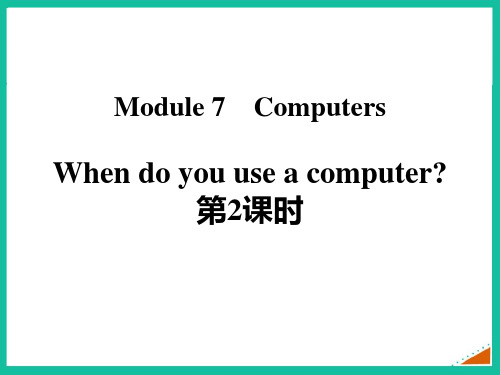
(C )14.Who sometimes uses the computer to watch movies? A.Dick. B.Dick’s mother. C.Dick’s sister. D.Dick’s father. ( )15.Which statement(表述) is RIGHT? B A.Dick and his sister are students. B.Dick and his family like computers. C.Dick sends emails to his friends every day. D.Dick’s father usually watches news on TV.
She thinks it’s great!She aslesnods27.
(发送)
messages(讯息) tobhecearufsreiends in China,28.
(因为) she wants to learn Chinese.
Tony is her brother.Tongaymloesves the computer too.But he
(B )1.A.him B.it C.its D.them (D )2.A.makes B.visits C.checks es (C )3.A.at B.in C.from D.of (A )rmation B.animals C.teachers D.books (A )5.A.sends B.send C.buy D.buys
三、词汇运用。 A)用方框中所给词的适当形式填空。
16.Don’t forget tworite
a name for the document.
17.Remember ctoonnect
剑桥国际少儿英语Book_2_Unit_7教案

《剑桥国际少儿英语》第二册教案Unit 7 At the farm单元目标语言:语词:farm, cow, duck, goat, lizard, sheep, spider, zoo, tree, give, frog, moo, baa, quack, croak, cluck, farmer, flowers, watermelon, pineapple, coconuts, lime, onions, Shirley, show, shop, tail,发音/∫/结构:So do I. I love (goats). I don’t.单元技能目标:听:学生能够听懂谈论喜欢的事物,以及表达同意与否。
能够听懂描述动物的谜语,并猜出此动物。
说:学生能够介绍自己喜欢的动物、蔬菜、水果,并对别人的介绍表达同意与否。
能够说、唱有关动物、水果的歌曲、歌谣。
读:学生能够认读本单元动物类单词,及朗读小故事。
写:学生能够正确书写本单元的六个动物类单词。
第一课时Lesson 1课型词汇教学目标学生将学会谈论农场里的动物,并认读这些单词。
目标语言重点语言farm, cow, duck, goat, lizard, sheep, spider, zoo, tree, give. 补充语言Let ’s …, nice, shoo, very funny, cages复习big, ugly, black, animals, baby, under, on, next to, eat, drink, bag, milk, bread, T-shirt, love, like, hair教学材料一个装有cow, duck, goat, lizard, sheep, spider 毛绒玩具或塑料仿真玩具的布袋子(如果没有可以用单词卡片代替),动物单词卡片(65-71),《剑桥国际少儿英语1》里的动物单词卡片47-52,59-65.CD2或磁带2A 。
新概念英语二课课件-2024鲜版

Common Phrase Pairing and Examples of Application
• Grammar and Analysis: Systematically explain the grammar knowledge involved in this lesson, including tense, voice, sentence structure, etc., and provide a large number of practice questions for learners to consolidate their knowledge.
• Mastering Grammar: Systematically learning English grammar knowledge, enabling learners to accurately apply various tenses, voices, and sentence structures.
• Summary, Review, and Outlook on Future Learning Directions
2024/3/28
3
01
Course Introduction and Teaching Objectives
2024/3/28
4
Overview of New Concept English Course
Intonation groups and pauses
Learn how to divide intonation groups and handle pauses to improve fluency and naturalness in English speaking.
Unit2Lesson7Jenny’sNewSkirt课件冀教版英语七年级上册
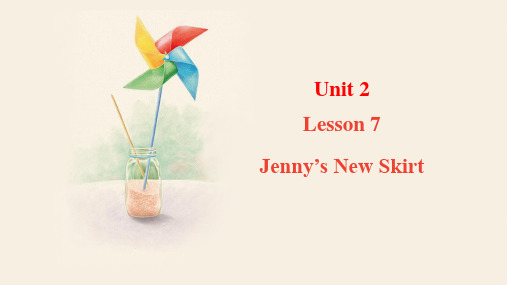
— Thanks! 谢谢!
当他人对你的容貌、服装等表示欣赏、赞 赏时,英语中的习惯应答为 “Thanks (a lot)./Thank you (very much). / Many thanks.”, 表示你高兴地接受这种赞赏,同时向对方 表示感谢。
Let’s Do It!
Interview some classmates and fill in the table. Then work in groups and talk about the results.
Name Favourite Clothes Favourite Colour
学习目标 新知学习 重点研讨 课堂小结 当堂检测
Unit 2 Lesson 7 Jenny’s New Skirt
新课 s
shorts
sweater shoes
blouse
shirt coat
T-shirt
Ready to go
学习目标
新知学习 重点研讨 课堂小结 当堂检测
Language Goal
A. White. B. Yes, I do. C. Blouses and skirts. D. No, it isn’t.
( C ) 5. What are your favourite clothes? E. Thanks.
blue blouse
pink
new light
学习目标
新知学习 重点研讨 课堂小结 当堂检测
Let’s Do It!
3 Look at Kim's closet and help her match some clothes.
Unit 2 Lesson 7 教案-2022-2023学年七年级英语下册同步精品课堂(冀教版)

年级Grade 7学科English备课组负责人课题Lesson 7:What's YourProject about?课型New主备人教学目标nguage goals:Grasp the words, phrases and structures: project, interest, still, anywhere, joke,places of interest, talk about, make a joke, work on.—What’s your project about? —My project is about….2.Ability goals:Can introduce the places of interest.3. Moral goals : Learn about differences between Chinese culture and western culture.教学重点1.Remember the key words and phrases and use them freely.2.Can introduce the places of interest.教学难点Remember the key words and phrases and use them freely. Learn to use simple past tense:教学方法Speaking, listening and reading板书设计Lesson 1 A Trip to China project talk aboutinterest places of intereststill work on.anywherejoke make a joke教学反思教师活动学生活动二次备课Step I: Lead inGreeting and free talk.• What did you do at class?•What did you talk about in class last week?Step II: Warm up•Have you ever been to any places of interest ?Can you introduce the place to your classmates?Step III: Listening tasks.Listen and write true (T) or false (F).1. Danny slept for three full days. ( )2. Jenny’s project is about Marco Polo. ( )3. Jenny and Danny will go home and work on their projects. ( )Step IV:Language PointsLet’s go to the library and work on our projects.work on 从事, 做......, 继续工作; 不断工作Mo Yan is working on a new story book now.Tom worked on in the office until ten o’clock last night. Step V: Reading tasks1.What is Danny’s project about?2. What is Danny’s joke?3. What is the Silk Road about?Step VI: Dig In Greeting and talk about the past!Know something about the places of interest .Listen and choose true or false.Learn the new phrases.Read the text carefully and answer the questions.What is a joke? A joke is something funny you say to make people laugh. Do you know any jokes in Chinese? Can you translate any jokes into English?Step VII: ExercisesMach the words with the correct meanings.Step VIII: Language Points1.You can find donuts anywhere in Canada. anywhere adv. 任何地方; 无论何处Sit anywhere you like.somewhere 到某处; 在某处用于肯定句中anywhere任何地方; 无论何处用于否定句或疑问句中nowhere 哪里都不本身具有否定含义everywhere 到处; 处处用于肯定句中1. I want to go __________ warm, it’s too cold here.2. Did you find ________ relaxing?3. I went ________ during the winter holiday, I just stay at home .4. He follows me ___________.2. Jenny and Danny talk about the trip and their projects.1. They were talking _______ their teacher.2. People began to talk ________ the story.3. They are talking ______the project ______ each other. Fill in the blanks with the given words.Read the text carefully and learn the word “joke”.Learn the new words.Listen, take notes and learn the new words and phrases. Translate the sentences into Chinese or English.project interest joke anywhere sleep hear1.Granny looked for her book, but she couldn't find it __.2. She shows an________in music.3.I am working on some new _____ (project) these days.4.I ______ a boy cry in the room last night.5.He closed his speech with a funny _________ .6.The mother __________ little last night, because her son was ill.Step IX: Free Talk• Do you know any places of interest in your city?• Where is the place of interest?• How old is it?• Why is it special?Step IX: SummaryKey words & phrases:project, interest, still, anywhere, jokeKey sentences:1. You can find donuts anywhere in Canada.2. Jenny and Danny talk about the trip and their projects.3. We learned so much.Danny and Jenny went on a _____ to China. After they came back, Danny was very tired. He ______ for twofull days. Now they are getting ready for their________. Jenny will talk about Marco Polo for her project. Danny’s project is about some places of interest in China. He will talk about some places and things they saw along the Do the exercise to practise the new words.Fill in the blanks with the words in the box.Talk about the places of interest freely.Summary and fill in the blanks.Silk Road. Will Danny talk about donuts? No! The Silk Road is about the _______and _______ of China. It’s not about donuts!HomeworkDo you know any places of interest in your city? Write about a place of interest you know and draw a picture of it.Task tips:Where is the place of interest?What is the name of it?Why is it special? How old is it?。
《Lesson 2》 说课稿
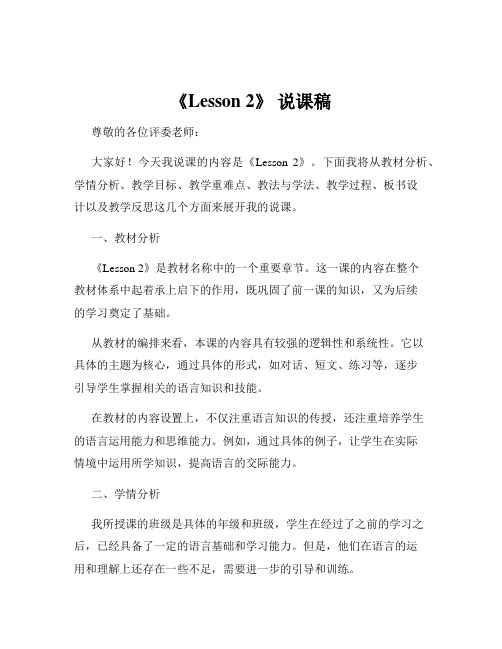
《Lesson 2》说课稿尊敬的各位评委老师:大家好!今天我说课的内容是《Lesson 2》。
下面我将从教材分析、学情分析、教学目标、教学重难点、教法与学法、教学过程、板书设计以及教学反思这几个方面来展开我的说课。
一、教材分析《Lesson 2》是教材名称中的一个重要章节。
这一课的内容在整个教材体系中起着承上启下的作用,既巩固了前一课的知识,又为后续的学习奠定了基础。
从教材的编排来看,本课的内容具有较强的逻辑性和系统性。
它以具体的主题为核心,通过具体的形式,如对话、短文、练习等,逐步引导学生掌握相关的语言知识和技能。
在教材的内容设置上,不仅注重语言知识的传授,还注重培养学生的语言运用能力和思维能力。
例如,通过具体的例子,让学生在实际情境中运用所学知识,提高语言的交际能力。
二、学情分析我所授课的班级是具体的年级和班级,学生在经过了之前的学习之后,已经具备了一定的语言基础和学习能力。
但是,他们在语言的运用和理解上还存在一些不足,需要进一步的引导和训练。
大多数学生对英语学习有着较高的兴趣,但也有部分学生存在学习动力不足、学习方法不当等问题。
因此,在教学过程中,我需要关注学生的个体差异,采取多样化的教学方法,激发学生的学习兴趣,提高课堂教学的效率。
三、教学目标基于对教材和学情的分析,我制定了以下教学目标:1、知识目标学生能够掌握本课的重点单词,如的读音、拼写和用法。
学生能够理解并正确运用本课的重点句型,如进行交流。
2、技能目标能够听懂与本课主题相关的简单对话和短文。
能够用所学的语言知识进行简单的口头和书面表达。
3、情感目标培养学生学习英语的兴趣和积极性,增强学习的自信心。
引导学生在学习过程中养成合作学习的习惯,培养团队精神。
四、教学重难点1、教学重点重点单词和句型的列举理解和掌握课文中的关键语法点2、教学难点如何让学生在实际情境中灵活运用所学的语言知识。
帮助学生突破语法点的难点,如五、教法与学法为了实现教学目标,突破教学重难点,我将采用以下教法和学法:1、教法情景教学法:通过创设生动的情景,让学生在真实的语境中学习和运用语言。
Lesson 2 Lesson
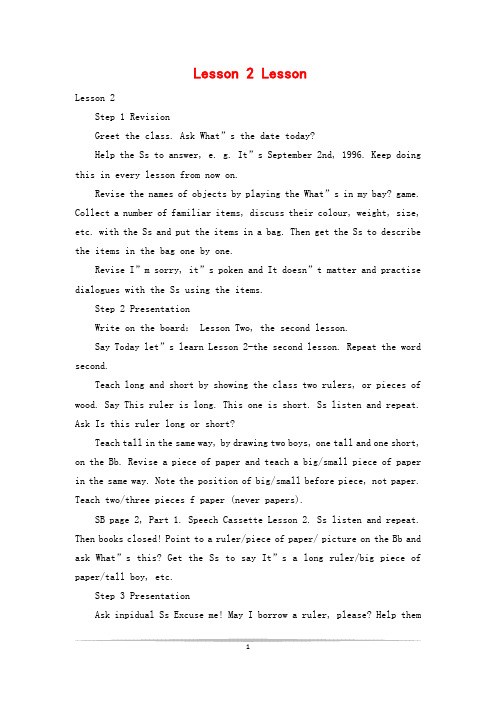
Lesson 2 LessonLesson 2Step 1 RevisionGreet the class. Ask What”s the date today?Help the Ss to answer, e. g. It”s September 2nd, 1996. Keep doing this in every lesson from now on.Revise the names of objects by playing the What”s in my bay? game. Collect a number of familiar items, discuss their colour, weight, size, etc. with the Ss and put the items in a bag. Then get the Ss to describe the items in the bag one by one.Revise I”m sorry, it”s poken and It doesn”t matter and practise dialogues with the Ss using the items.Step 2 PresentationWrite on the board: Lesson Two, the second lesson.Say Today let”s learn Lesson 2-the second lesson. Repeat the word second.Teach long and short by showing the class two rulers, or pieces of wood. Say This ruler is long. This one is short. Ss listen and repeat. Ask Is this ruler long or short?Teach tall in the same way, by drawing two boys, one tall and one short, on the Bb. Revise a piece of paper and teach a big/small piece of paper in the same way. Note the position of big/small before piece, not paper. Teach two/three pieces f paper (never papers).SB page 2, Part 1. Speech Cassette Lesson 2. Ss listen and repeat. Then books closed! Point to a ruler/piece of paper/ picture on the Bb and ask What”s this? Get the Ss to say It”s a long ruler/big piece of paper/tall boy, etc.Step 3 PresentationAsk inpidual Ss Excuse me! May I borrow a ruler, please? Help them1to answer Certainly! Here you are. Then say Thanks. Oh, sorry, this is short, Do you have a long one, please? Help the Ss to answer Oh, yes, I do or Sorry! I don”t.Step 4 PracticeSB page 2, Part 2. Speech Cassette Lesson 2. Ss listen and repeat, then practise in pairs. Contrast borrow (for an item that will be returned after use) and have (for an item that will not be returned ).SB page 2, Part 3. Ss make three new dialogues.Get some pairs to act theirs out.Step 5 ListeningRead the following listening text. Demonstrate what the Ss have to do as you speak. Do not move on until the Ss have carried out an instruction.Listening textDo you all have a piece of paper like this? Hold it like this, and fold it in half like this.Write your name in Chinese on one side, here; on the other side, write your name in English.Begin your family name and your first name with a capital letter - a big letter. But use small letters for the other letters in your name. When you finish writing your name, put the piece of paper on your desk. Put it on your desk so I can see your names in English!This will help me to know your names!When the Ss have finished the exercise, talk to some of the Ss, like this: Hello, (Name). How are you?Step 6 WorkbookWb Lesson 2, Exx. 1-3.Ex. I is a written exercise. The answers are: a bottle of milk, four small pieces of paper, two long rulers, five bottles of water, eight pieces2of pead, six small bags of tea, one big bag of rice, two kilos of fish. Ex. 2 may be done orally in class. The answers are: 1-d, 2 -e, 3 -b, 4 -a, 5 -c.Ex.3 may be done orally first, and then in writing. The missing words are: Excuse me;Certainly; this one; Thanks:Do you have a small one?; I don”t. HomeworkFinish off the workbook exercises.3。
冀教版英语七年级上册 Unit2 Lesson 7导学案
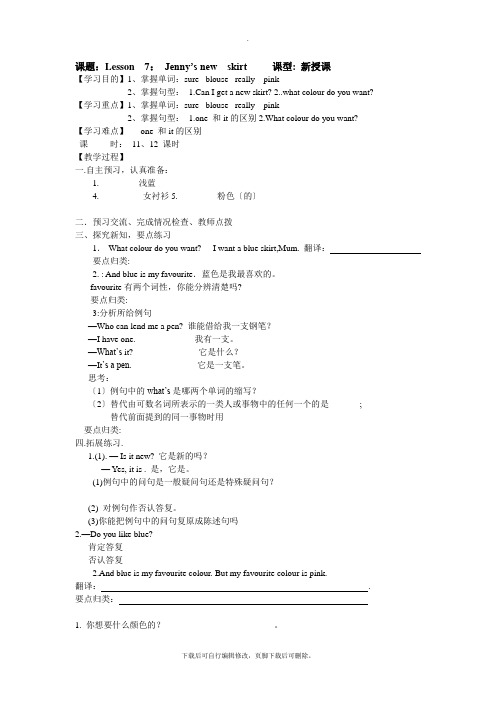
课题:Lesson 7:Jenny’s new skirt 课型: 新授课【学习目的】1、掌握单词:sure blouse really pink2、掌握句型:1.Can I get a new skirt? 2..what colour do you want? 【学习重点】1、掌握单词:sure blouse really pink2、掌握句型:1.one 和it的区别2.What colour do you want?【学习难点】one 和it的区别课时:11、12 课时【教学过程】一.自主预习,认真准备:1.________ 浅蓝4.__________女衬衫5.________ 粉色〔的〕二.预习交流、完成情况检查、教师点拨三、探究新知,要点练习1.-What colour do you want? -I want a blue skirt,Mum. 翻译:要点归类:__________________________________________________________2. : And blue is my favourite.蓝色是我最喜欢的。
favourite有两个词性,你能分辨清楚吗?要点归类:__________________________________________________________ 3:分析所给例句—Who can lend me a pen? 谁能借给我一支钢笔?—I have one. 我有一支。
—What’s it? 它是什么?—It’s a pen. 它是一支笔。
思考:〔1〕例句中的what’s是哪两个单词的缩写?______ _______〔2〕替代由可数名词所表示的一类人或事物中的任何一个的是_______;替代前面提到的同一事物时用_______要点归类:__________________________________________________________四.拓展练习.1.(1). — Is it new? 它是新的吗?— Yes, it is . 是,它是。
二年级下册英语教案Unit7Lesson2_先锋英语
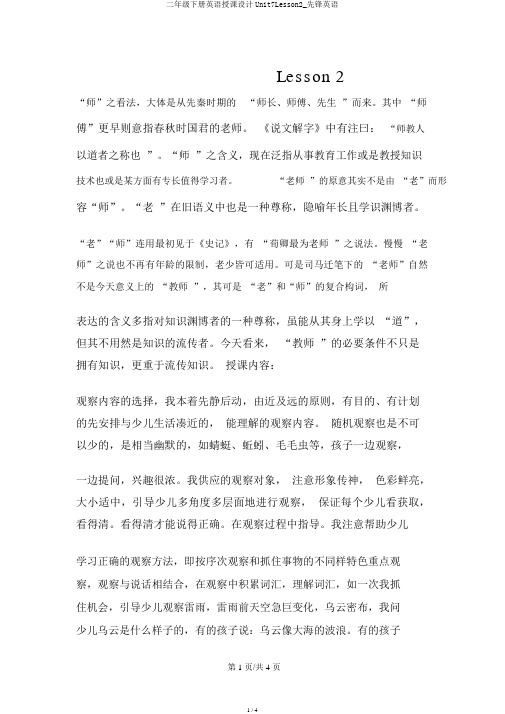
Lesson 2“师”之看法,大体是从先秦时期的“师长、师傅、先生”而来。
其中“师傅”更早则意指春秋时国君的老师。
《说文解字》中有注曰:“师教人以道者之称也”。
“师”之含义,现在泛指从事教育工作或是教授知识技术也或是某方面有专长值得学习者。
“老师”的原意其实不是由“老”而形容“师”。
“老”在旧语义中也是一种尊称,隐喻年长且学识渊博者。
“老”“师”连用最初见于《史记》,有“荀卿最为老师”之说法。
慢慢“老师”之说也不再有年龄的限制,老少皆可适用。
可是司马迁笔下的“老师”自然不是今天意义上的“教师”,其可是“老”和“师”的复合构词,所表达的含义多指对知识渊博者的一种尊称,虽能从其身上学以“道”,但其不用然是知识的流传者。
今天看来,“教师”的必要条件不只是拥有知识,更重于流传知识。
授课内容:观察内容的选择,我本着先静后动,由近及远的原则,有目的、有计划的先安排与少儿生活凑近的,能理解的观察内容。
随机观察也是不可以少的,是相当幽默的,如蜻蜓、蚯蚓、毛毛虫等,孩子一边观察,一边提问,兴趣很浓。
我供应的观察对象,注意形象传神,色彩鲜亮,大小适中,引导少儿多角度多层面地进行观察,保证每个少儿看获取,看得清。
看得清才能说得正确。
在观察过程中指导。
我注意帮助少儿学习正确的观察方法,即按序次观察和抓住事物的不同样特色重点观察,观察与说话相结合,在观察中积累词汇,理解词汇,如一次我抓住机会,引导少儿观察雷雨,雷雨前天空急巨变化,乌云密布,我问少儿乌云是什么样子的,有的孩子说:乌云像大海的波浪。
有的孩子说“乌云跑得飞快。
”我加以必然说“这是乌云滔滔。
”当少儿看到闪电时,我告诉他“这叫电光闪闪。
”接着少儿听到雷声惊叫起来,我抓住机会说:“这就是雷声隆隆。
”一会儿下起了大雨,我问:“雨下得怎样?”少儿说大极了,我就舀一盆水往下一倒,作比较观察,让少儿掌握“倾盆大雨”这个词。
雨后,我又带少儿观察明亮的天空,朗诵自编的一首儿歌:“蓝天高,白云飘,鸟儿飞,树儿摇,太阳公公咪咪笑。
新概念第二册一课一练lesson7说课材料
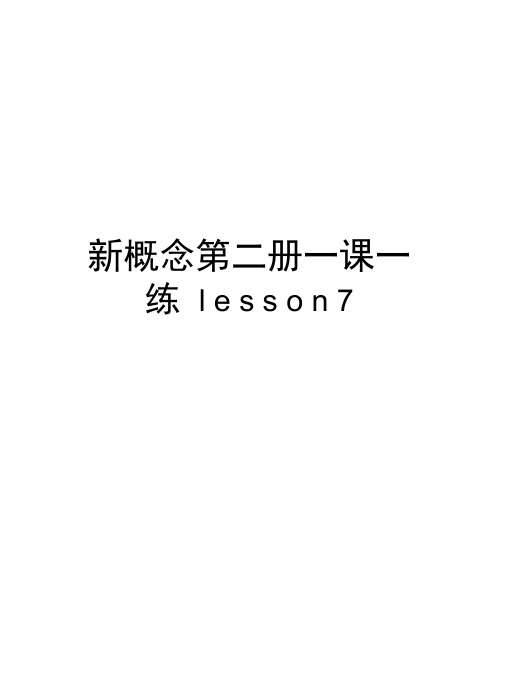
新概念第二册一课一练l e s s o n 7Lesson 7I根据括号内所给的汉语提示写出相应的英语单词,并注意运用其正确形式。
1. He is _______ 等待)for a friend at the station.2. There is a high building near the _______ 主要的)to me.3. This handbag is very _____ 珍贵的)to me.4. He is going to the ______飞机场)to meet his brother.5. He was a ______ 侦探),but now he has already retired.6. This is the most ______ 贵重的)thing that i have ever seen.7. The boy _______ 偷)a wallet but later he was caught by the policeman.8. There is lots of ________沙子)on the beach.9. I received a________ 包裹)from my parents yesterday.10. Three policema n are keepin ______ 警戒)at the doorII用括号中所给动词的正确形式填空。
1. As I _____ (get) off the bus, some one called me.2. Tom is watching television while Jane ______ (do) her homework.3. We were sitting in the living room when it ______ (begin) to rain.4. The telephone rang just as I ____ (leave) the house.5. While he _______ (water) the garden, his wife was cooking in the kitchen. III单项选择(从A,B,C和D中选出最佳选项)。
2024年冀教版七年级英语上册教学 Lesson 2 Amazing English

Lesson 2Amazing English教学目标通过本课的学习,学生能够:1.熟练朗读课文,并用自己的语言简单概括本课内容。
(学习理解)2.在语境中正确运用only、than、million、level、therein、even、phrase、piece、sentence、quick、fox、lazy等词汇。
(应用实践)3.了解有关英语的特点,发现英语的神奇,享受学习英语的乐趣。
(迁移创新)语篇研读What: 本课语篇主要通过列举一些特殊的单词、短语和句子介绍英语的神奇之处。
Why:语篇通过讲述英语的神奇之处,让学生了解英语的特点,提高学生学习英语的兴趣。
How: 语篇采用“总—分—总”的形式写作。
第一段总起讲述虽然英语只有26个字母,但是可以组成超过一百万个单词;第二至七段列举了令人惊奇的单词、短语和句子来展示英语的神奇;最后一段总结全文并发起倡议,让学生好好享受学习英语的乐趣。
教学过程设计理念:以《义务教育英语课程标准(2022年版)》核心素养为导向,以单元主题为引领,基于语篇的育人理念,体现《义务教育英语课程标准(2022年版)》“学通过练习,了解更多短语的含义Check the answers in class. 确地理解短语含义,能否在有限的时间内完成相关任务设计意图通过选择练习检查学生对英语短语的理解及对本课话题的掌握情况,增加知识储备,同时提升学生解决实际问题的能力【应用实践】板书设计Lesson 2 Amazing EnglishAmazing factsabout English {letter —26 letters :morethan onemillion words word —level :left to right or right to left (the same )tℎerein :10 wordsphrase —apiece of cake :easysentence —Tℎe quick brown fox jumps over tℎe lazy dog :26 letters作业设计基础型作业:1.Remember the new words of the lesson.2.Read the passage fluently.实践型作业: Find more interesting facts about English and share them with your group members. 教学反思。
四年级下册英语教案Lesson 2 What colour are the trousers 第二课
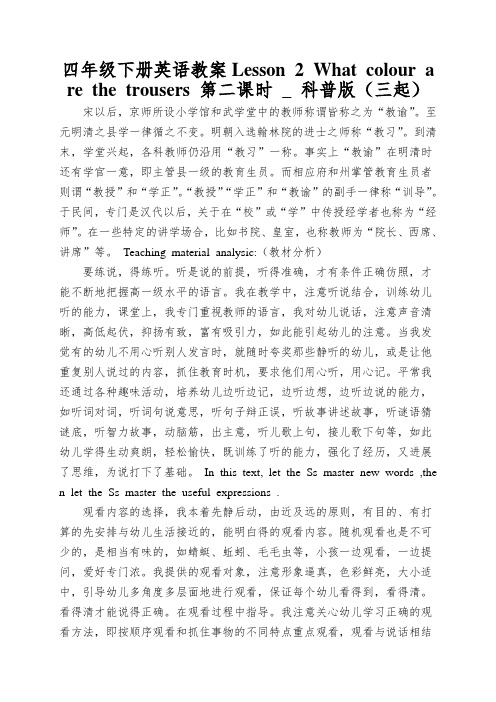
四年级下册英语教案Lesson 2 What colour a re the trousers 第二课时_ 科普版(三起)宋以后,京师所设小学馆和武学堂中的教师称谓皆称之为“教谕”。
至元明清之县学一律循之不变。
明朝入选翰林院的进士之师称“教习”。
到清末,学堂兴起,各科教师仍沿用“教习”一称。
事实上“教谕”在明清时还有学官一意,即主管县一级的教育生员。
而相应府和州掌管教育生员者则谓“教授”和“学正”。
“教授”“学正”和“教谕”的副手一律称“训导”。
于民间,专门是汉代以后,关于在“校”或“学”中传授经学者也称为“经师”。
在一些特定的讲学场合,比如书院、皇室,也称教师为“院长、西席、讲席”等。
Teaching material analysic:(教材分析)要练说,得练听。
听是说的前提,听得准确,才有条件正确仿照,才能不断地把握高一级水平的语言。
我在教学中,注意听说结合,训练幼儿听的能力,课堂上,我专门重视教师的语言,我对幼儿说话,注意声音清晰,高低起伏,抑扬有致,富有吸引力,如此能引起幼儿的注意。
当我发觉有的幼儿不用心听别人发言时,就随时夸奖那些静听的幼儿,或是让他重复别人说过的内容,抓住教育时机,要求他们用心听,用心记。
平常我还通过各种趣味活动,培养幼儿边听边记,边听边想,边听边说的能力,如听词对词,听词句说意思,听句子辩正误,听故事讲述故事,听谜语猜谜底,听智力故事,动脑筋,出主意,听儿歌上句,接儿歌下句等,如此幼儿学得生动爽朗,轻松愉快,既训练了听的能力,强化了经历,又进展了思维,为说打下了基础。
In this text, let the Ss master new words ,then let the Ss master the useful expressions .观看内容的选择,我本着先静后动,由近及远的原则,有目的、有打算的先安排与幼儿生活接近的,能明白得的观看内容。
随机观看也是不可少的,是相当有味的,如蜻蜓、蚯蚓、毛毛虫等,小孩一边观看,一边提问,爱好专门浓。
四年级下册英语教案_Lesson 2 Is this your pencil?|冀教版
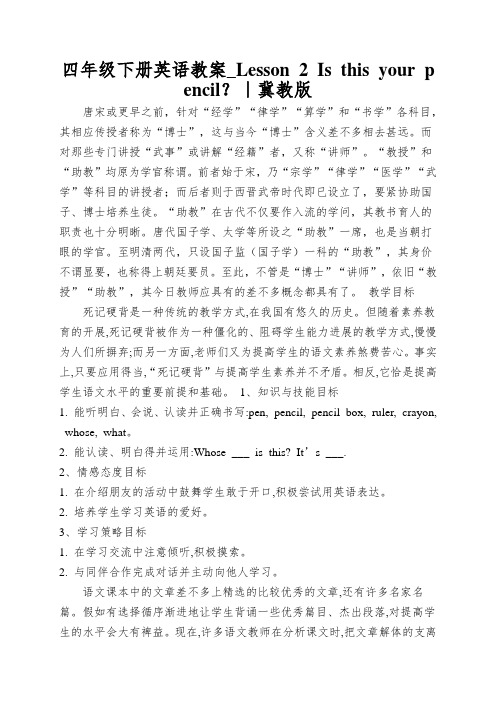
四年级下册英语教案_Lesson 2 Is this your pencil?|冀教版唐宋或更早之前,针对“经学”“律学”“算学”和“书学”各科目,其相应传授者称为“博士”,这与当今“博士”含义差不多相去甚远。
而对那些专门讲授“武事”或讲解“经籍”者,又称“讲师”。
“教授”和“助教”均原为学官称谓。
前者始于宋,乃“宗学”“律学”“医学”“武学”等科目的讲授者;而后者则于西晋武帝时代即已设立了,要紧协助国子、博士培养生徒。
“助教”在古代不仅要作入流的学问,其教书育人的职责也十分明晰。
唐代国子学、太学等所设之“助教”一席,也是当朝打眼的学官。
至明清两代,只设国子监(国子学)一科的“助教”,其身价不谓显要,也称得上朝廷要员。
至此,不管是“博士”“讲师”,依旧“教授”“助教”,其今日教师应具有的差不多概念都具有了。
教学目标死记硬背是一种传统的教学方式,在我国有悠久的历史。
但随着素养教育的开展,死记硬背被作为一种僵化的、阻碍学生能力进展的教学方式,慢慢为人们所摒弃;而另一方面,老师们又为提高学生的语文素养煞费苦心。
事实上,只要应用得当,“死记硬背”与提高学生素养并不矛盾。
相反,它恰是提高学生语文水平的重要前提和基础。
1、知识与技能目标1. 能听明白、会说、认读并正确书写:pen, pencil, pencil box, ruler, crayon, whose, what。
2. 能认读、明白得并运用:Whose ___ is this? It’s ___.2、情感态度目标1. 在介绍朋友的活动中鼓舞学生敢于开口,积极尝试用英语表达。
2. 培养学生学习英语的爱好。
3、学习策略目标1. 在学习交流中注意倾听,积极摸索。
2. 与同伴合作完成对话并主动向他人学习。
语文课本中的文章差不多上精选的比较优秀的文章,还有许多名家名篇。
假如有选择循序渐进地让学生背诵一些优秀篇目、杰出段落,对提高学生的水平会大有裨益。
现在,许多语文教师在分析课文时,把文章解体的支离破裂,总在文章的技巧方面下功夫。
- 1、下载文档前请自行甄别文档内容的完整性,平台不提供额外的编辑、内容补充、找答案等附加服务。
- 2、"仅部分预览"的文档,不可在线预览部分如存在完整性等问题,可反馈申请退款(可完整预览的文档不适用该条件!)。
- 3、如文档侵犯您的权益,请联系客服反馈,我们会尽快为您处理(人工客服工作时间:9:00-18:30)。
Step 4: Interpretation of the Results
The solution of the governing equations gives the displacements, velocities, and accelerations of the various masses of the system. These results must be interpreted with a clear view of the purpose of the analysis and the possible design implications of the results.
A spring is generally assumed to have negligible mass and damping. A force developed in the spring is given by
F = kx,
where F is the spring force, x is the displacement of one end with respect to the other, and k is the spring stiffness or spring constant. Copyright 2007 by Withit Chatlatanagulchai
208322 Mechanical Vibrations Lesson 2 The work done in deforming a spring is stored as strain or potential energy in the spring and is given by
1 U = kx 2 . 2
2 Vibration Model: Mechanical Elements
As discussed before, a vibratory system consists of three elements: mass, spring, and damper.
2.1 Spring Elements
Step 3: Solution of the Governing Equations
The equations of motion must be solved to find the response of the vibrating system. We can use the following techniques for finding the solution: • Standard methods of solving differential equations • Laplace transform methods • Numerical methods • Matrix methods In this course, we will focus on the first three methods; each method will be discussed in the following lessons. The last method, namely, matrix methods are mostly used in higher degree of freedom and can be studied once the students are familiar with linear algebra.
⎧ Px 2 ( 3a − x ) , ⎪ ⎪ 6 EI y ( x) = ⎨ 2 ⎪ Pa ( 3 x − a ) , ⎪ 6 EI ⎩
0≤ x≤a , a≤ x≤l
(1)
where E is Young’s modulus, I is moment of inertia of the cross section of the beam, and P is external force. Find the spring constant of a cantilever beam with an end mass m shown in Figure 5.
208322 Mechanical Vibrations Lesson 2
1 Vibration Analysis Procedure
The analysis of a vibrating system usually involves four steps: mathematical modeling, derivation of the governing equations, solution of the equations, and interpretation of the results.
Figure 1: A forging hammer. Solution
1
Copyright 2007 by Withit Chatlatanagulchai
208322 Mechanical Vibrations Lesson 2
Figure 2: A motorcycle with a rider. Solution
Step 2: Derivation of Governing Equations
Once the mathematical model is available, we use the principles of dynamics and derive the equations that describe the vibration of the system. The equations of motion can be derived by drawing the free-body diagrams of all the masses involved. The equations of motion of a vibrating system are in the form of a set of ordinary differential equations for a discrete system and partial differential equations for a continuous system. The equations may be linear or nonlinear, depending on the behavior of the components of the system. Several approaches are commonly used to derive the governing equations. They are • Newton’s second law of motion • Energy method • Equivalent system method (Rayleigh’s method) 3
Step 1: Mathematical Modeling
Mathematical model represents all the important features of the system for the purpose of deriving the mathematical equations governing the system’s behavior. The mathematical model should include enough details to be able to describe the system in terms of equations without making it too complex. The mathematical model may be linear or nonlinear, depending on the behavior of the system’s components. Linear models permit quick solutions and are simple to handle; however, nonlinear models sometimes reveal certain characteristics of the system that cannot be predicted using linear models. First, we can use a very crude or elementary model to get a quick insight into the overall behavior of the system. Subsequently, the model is refined by including more components and details so that the behavior of the system can be observed more closely. ☻ Example 1: [1] Consider a forging hammer shown in Figure 1. The forging hammer consists of a frame, a falling weight known as the tup, an anvil, and a foundation block. The anvil is a massive steel block on which material is forged into desired shape by the repeated blows of the tup. The anvil is usually mounted on an elastic pad to reduce the transmission of vibration to the foundation block and the frame. Come up with two versions of mathematical model of the forging ha2007 by Withit Chatlatanagulchai
